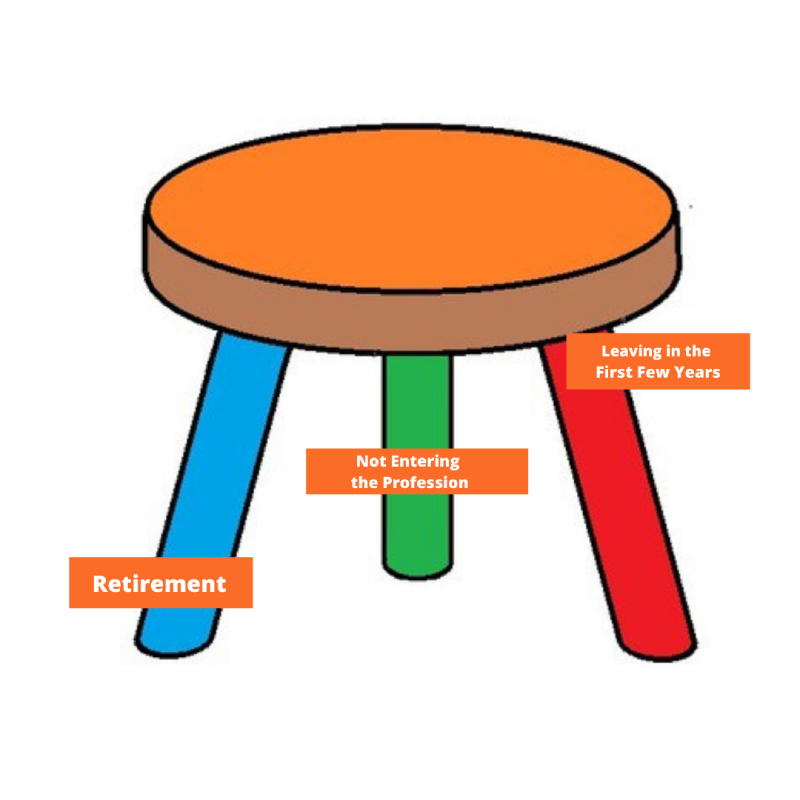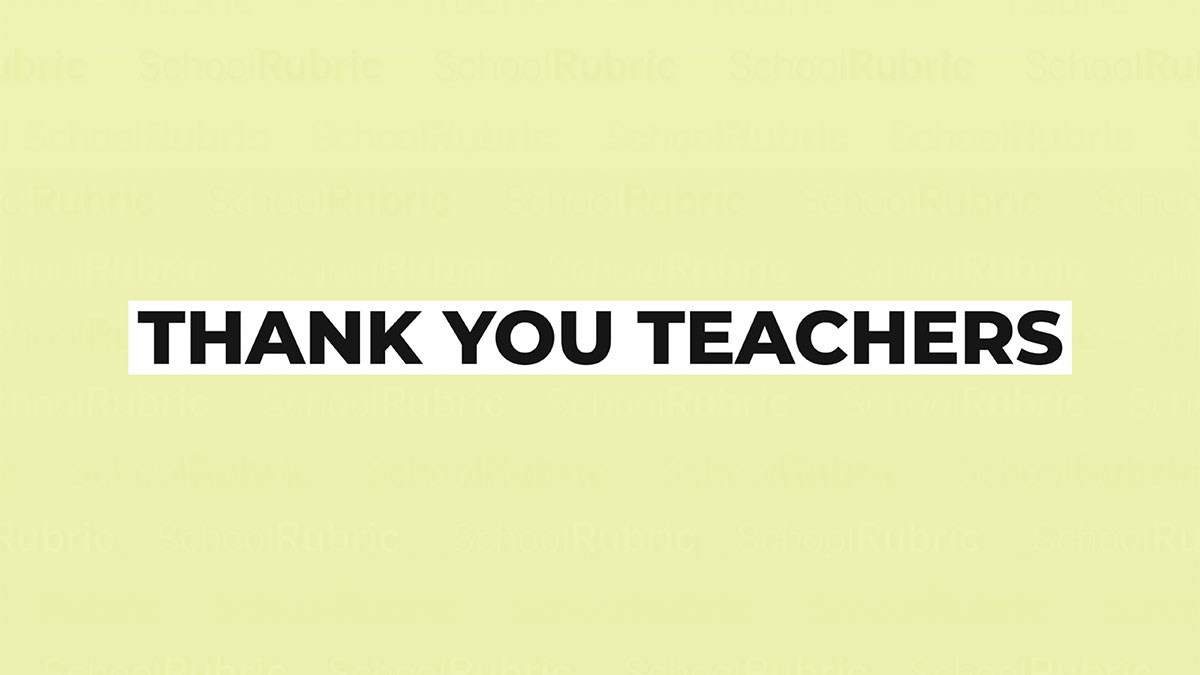The Looming Teacher Shortage and What We Can Do About It Now

Ask almost anyone to list the most influential people in their life, and most often a teacher will make the list. Teachers are often referred to as the backbone of the education system; they play a pivotal role in shaping the minds of young people. They are credited with being “difference makers”.
Schools cannot operate successfully without dedicated teachers, but we are standing on the precipice of a massive teacher shortage. All indicators are that a teacher shortage is real–and the timing is right now! According to Lisette Partelow, senior director of K-12 Strategic Initiatives at the Center for American Progress, “since 2010, total enrollment nationwide in teacher preparation programs has declined by more than one-third; this decline has occurred in the context of increasing enrollment in bachelor’s degree programs nationwide over the same period.”
Why have the numbers fallen? And so rapidly? Linking high-stakes testing to teacher pay and evaluations certainly hasn’t been an encouragement to young college students to enter the teaching profession. Add in the erosion of tenure protections, budget cuts, public degradation of teachers, competitive pay in comparison to their college counterparts, increased workload— and you got the making of a crisis! We now stand on the precipice of that crisis–a drastic shortage of people entering the field of education.
Attracting college students into the profession is only part of the picture when we are talking about the looming teacher shortage. It’s like a three-legged stool: not enough teacher candidates, teachers leaving within the first 5 years of teaching, and teachers opting for early retirement.

The first leg is that there are not enough qualified candidates as indicated above. University students are just not considering a career in education at the rate in previous years. “For the first time in years, a majority of parents surveyed by PDK International in 2018 said that they do not want their children to become teachers, due to low salaries, difficult working conditions, and a lack of career pathway opportunities. The teaching profession as a whole cannot compare with other high-status professions such as medicine and law.” Parents have a lot of influence over college students’ choices for a career since they are often providing financial support, and they are not supporting a career in education.
The second leg of the teacher shortage stool is that many educators are leaving the field within the first five years of entering the profession for many of the same reasons that people are choosing not to enter the profession in the first place, in addition to the loss of respect for educators and increased workload. The altruistic and eternally optimistic educators are hitting a wall much earlier than in decades past–and they are realizing that they have choices. Many teachers are leaving the teacher position within the first five years of entering the profession.
The last leg of the shaky stool is that we have a record number of baby boomers and Generation X educators who are getting ready to retire. Many have decided that teaching through a pandemic was utterly exhausting! A record number of educators are applying for retirement– and all of this spells BIG trouble for the entire education system. They are leaving behind the classroom with no suitable replacement.
No doubt, we are headed for a crisis in filling classrooms and schools with qualified and passionate teachers, but there are things that we can do now to avoid the catastrophic shortage of “Fired Up” teachers in the years to come. Our future students are counting on us to ensure that every classroom is filled with passionate teachers who are dedicated to their success–and to help them become the very best versions of themselves. We can avert the impending shortage of teachers, but we need to get started NOW!

Attracting Students into the Education Profession
Let’s start with first things first, attracting people into the education field. My current position as a strategic marketing coordinator helps me to see past the classroom walls and school campus boundary lines and understand how a school’s brand helps to attract great quality staff members.
Diversity, equity, and inclusion (DEI) may be a buzzword right now in almost every sector, but don’t count it out as a fad. The importance of making people feel like they belong is paramount to creating a great culture for all. Develop a strategic plan for recruiting and supporting diverse educators and administrators. People go where they feel wanted and comfortable. Make your school district appealing to diverse candidates through every type of recruitment strategy that you employ.
Every administrator knows that school culture is the foundation for just about everything that happens in a school. When staff members feel supported and valued, they want to stay. Who creates the culture of an organization? Most of the time it’s the boss. Whom you choose as the leader of a school matters more than you think. It is said that “People don’t leave their job, they leave their boss.” Selecting the absolute best candidate to lead your school is the most important thing that you can do in ensuring the creation of a school culture that attracts qualified and passionate candidates.
People talk! What they say about your school on social media, sporting events, and the grocery store matters. Often, people make a judgment about your school-based upon what they have heard, so make sure that what they are hearing is good stuff! Be loud and proud about the accomplishments of your school and staff. Be so loud that you drown out the negative!
Why not create a Future Educators of America chapter in your school to promote education as a career choice? Building interest in the field of education can plant a seed into the young minds that teaching is an honorable career choice. Ensure that guidance counselors are highlighting education as a career choice.
Elevating the conversation about the profession of education in a positive light can not only help your school attract candidates but can also inspire and encourage people into the field of education. Belonging to organizations that promote the profession will help not only your school but all schools. Participate in nationwide public relations campaigns designed to positively promote education as a top career choice. We are all in this together!

Stop the 5-year Exodus
According to the US Department of Education, “Nearly half of individuals who begin a career in teaching leave the profession within the first five years.” Supporting teachers during their first five years is a critical piece in retaining quality educators and keeping them so fired up that they don’t want to leave the classroom. We should certainly consider loan forgiveness, additional pay, grants, incentive programs, and such, but in addition, we need to strongly focus on how we support our new teachers.
Teachers move through 4 stages during their teaching career: fantasy, survival, mastery, and impact, as outlined in the book Fired Up Teachership, by yours truly and Dr. Frank Rudnesky. New teachers beginning their careers enter their first few years fantasizing about what teaching is and the difference that they will make in their schools and with their students. We can only hope that they remain in this stage for a few years, but often they are catapulted into survival mode. SGO’s PIP’s Core Curriculum Standards, lesson plans, classroom leadership, and so much more, cause them to be completely overwhelmed and consider leaving the profession. It doesn’t have to be that way! We can–and should–develop strong new teacher academies that support our new staff members during the survival stage. Selecting the right mentor is critical. Make sure that the mentor-mentee relationship is a good match. (not just whoever volunteers to be a mentor). Check-in with both the mentor and mentee to see if it is a workable relationship between them. This single relationship can be the make-or-break support needed to stop new teachers from leaving. The support of a great mentor cannot be underestimated! That being said, how are you attracting the mentors in your school? and what are you taking off of their plate to allow them to be great mentors?
Oftentimes, administrators are looking to the new teachers to fill in the gaps of positions vacated by veteran teachers in extracurricular activities and athletics. I get it! You have people who are in that fantasy stage exuding limitless energy and they want to say yes to anything that you ask, but everything that you ask them to do, in addition to their main role as a teacher, is taking away from moving into the mastery stage of teaching where they have procedures and transitions down pat. We are taking them away from developing more innovative and engaging lessons—and we risk overwhelming them to the point that they consider leaving the field because they never feel like they have a break. I have heard of a school district that prohibited first-year teachers from doing any coaching or advisor roles to allow them to develop the critical skills and routines to make teaching manageable. What a great idea!
One of the things that stress new teachers out the most is observations. Have your administrators work with your new teachers to be a support throughout the first few years so that they do not see the observations as a “gotcha”. Administrators should show up often to check-in and support the newbies. Build a relationship of trust between members of the administration and teachers so that anytime that an administrator is in the classroom, it is a positive learning experience for the new teachers.
Encourage and permit peer-to-peer observations throughout the year. Not only is this a great idea for new teachers, but it has also shown to be extremely beneficial for all staff members. Getting out of their silos to see what other teachers are doing can inspire and reinvigorate even the most seasoned teacher, but it is essential for the new teachers. The members of the administration should plan opportunities for the new teachers to observe other teachers in the building. Select teachers who are role models exuding great classroom leadership and mastery of curriculum.
Keep Them Fired Up and Wanting to Stay
We hear it all the time…the countdown to retirement. Certain staff members mention how long they have left until they can retire. And truth be told, some really should. They have lost their spark and forgotten “their way”. Those are not the teachers that we need to stop from leaving the profession, but some teachers are on the cusp of being able to leave and wanting to or possibly staying in the classroom to make an impact. These teachers need support too. There are things that we can do to keep them fired up.
The support that these teachers require can be quite different from the necessary support for our new teachers. These veteran staff members should have the time management and classroom leadership down so their focus is different. Creating opportunities for individual professional development for teachers who want to expand their knowledge specifically in their curriculum, use of technology, or building professional learning communities or networks should be supported and encouraged. Oftentimes, these opportunities are the first to go in tight budget times. School districts should ensure that there is money in the budget for continued and relevant professional development(on-site and off-site) for teachers at all stages in their careers. What a great boost for teachers to attend PD that is in their area of concentration or will expand their repertoire of skills!
Keeping veteran teachers up to date with the newest technology and software is critical to keeping them feeling confident in the ever-changing landscape of education. Things have dynamically changed in the teaching profession with the infusion of smart boards, 1:1 devices, software, and apps. These teachers need to feel secure in their use of technology before they incorporate it into the classroom. Creating a technology academy for teachers to grow their technical skills is a great way to bring them aboard the technology train. (Make sure to provide coverage or offer a stipend to attend or it just becomes another thing for them to do and they may become resentful.)

Bring them in and let them have a voice! In a comparison across 14 professions, teaching ranked last among respondents who felt that their “opinions seem to count,” or included workplaces with “an environment that is trusting and open.”
Seasoned teachers are an integral part of the school community and they are certainly culture builders. Give them a voice in decisions being made, particularly ones that affect them the most. That doesn’t mean that they have the final say, but they should have input and be heard. This is a win-win for both the school district and the staff members. They often offer viable solutions and innovative ideas that benefit the school as a whole and they feel a valued member of the school community. You will be building a culture of “we”. A collective culture is always better than a top-down one.
Unlike the new teachers who need more support in the classroom, the seasoned teachers need more autonomy. They are professionals who, hopefully, have been observed and shaped into master teachers who make an impact on the students in the school. Trust them! Give them opportunities to work outside of the box to deliver and facilitate great learning experiences for the students. Encourage them, or better yet, join them in trying out new ideas.
Been there, done that! Yes, these teachers have probably coached, advised, or participated in numerous extracurricular activities and/or sports for a great number of years. They are your go-to people to assist with the many things going on in your school. But, they may be looking for different opportunities to grow and stretch, personally or professionally. Make sure that you do not lean on the same people to hold up the school. These people get tired. Let someone else have an opportunity. Sure, you will have to guide them through the process or procedures, but it will be worth it.
There is no shortage of leadership opportunities in a school; that’s a fact. But many of them either require teachers to leave their classroom or they are in addition to the role of being a classroom teacher. Why not create hybrid positions that allow the master teachers to support the school in a leadership role in place of some classroom time? Or, if that is not possible, offer compensation of some sort and take something else off of their plates so they can support the school as a teacher leader. Most teachers want to serve to make an impact outside of the classroom, but they just don’t have the time. Make it feasible for them to stay rooted as a teacher but spread their wings as a leader.
We may be seriously challenged in attracting and keeping teachers fired up in our schools today, but we can do something about it. We can abate the devastating effects of this impending crisis of a massive teacher shortage, but we need to start now!
This article is available and can be accessed in Spanish here.









